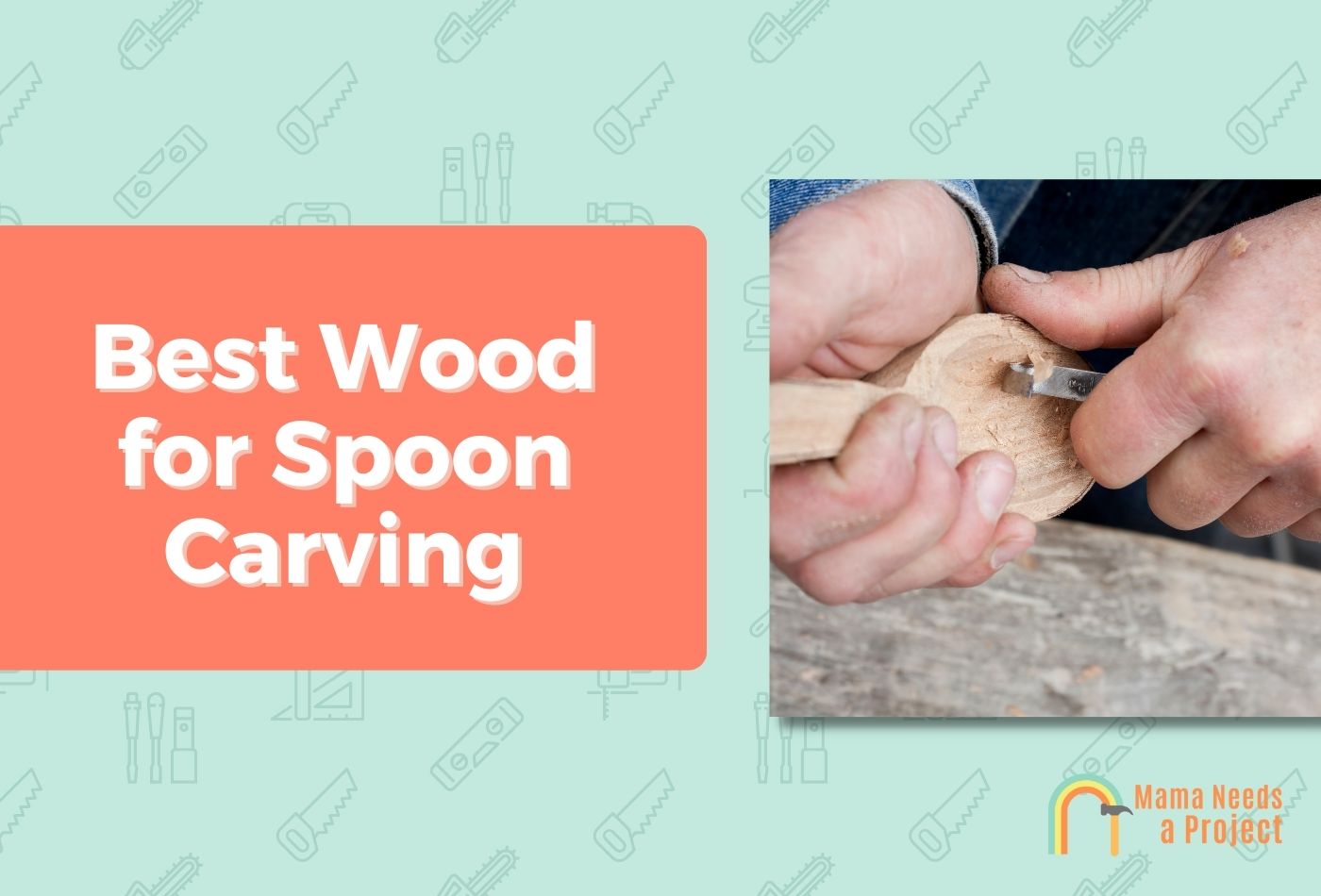7 Best Woods for Spoon Carving (& Ones to Avoid!)
Wooden spoon making is a beautiful art form. Not only is this fun wood craft idea an ode to the natural elegance of trees, but it also has a delightfully functional end result.
Just one quality wood spoon can last you 5 years of dining. These adorable kitchen eating utensils are also quite sellable, which is an added bonus.
If you’re just starting your spoon carving journey, you’re probably unsure about what the best wood for spoon carving is. This post is going to cover what wood is best for carving spoons, and what woods to steer clear of.
- The best wood for spoon carving is going to be soft enough to manipulate with a chisel, but on the harder side with a tight grain for preventing bacterial growth.
- Seven great woods for spoon carving are: birch, alder, lime wood, apple, maple, black walnut, and cherry.
- It’s best to avoid soft and porous woods, including pine, spruces, oaks, and ashes.
Best Wood For Spoon Carving
When you’re just getting started with carving anything, especially smaller items like spoons, you want to choose a wood that’s not too hard to work with.
Aim to select a hardwood that’s on the softer side.
Besides a wood’s malleability, it’s extremely important to consider the toxicity of a wood as well. We are making something that goes inside our mouths and touches our food, after all!
Hardwoods are typically non-toxic, including birch, maple, and walnut. These are food-safe. It’s the softwoods you have to watch out for!
Anyway, you won’t need to overthink your choice after reading through this post. I’ve rounded up the seven best woods that are perfect for beginners and experienced carvers alike. Let’s get into it!
1. Birch
Kicking off our list is birch, a strong, medium-weight wood with a close grain and a nice light brown color. It’s not as fibrous as many comparable woods, providing a lovely, smooth finish.
This is a great choice for beginner carvers. It’s easy to shape with hand tools, while being strong enough to last with a Janka hardness of 4,000N.
Betula papyrifera, or paper birch, with its iconic white bark, is a highly accessible material in North America. This makes it an affordable option.
If you choose a birch species for your spoon project, remember that green birch is easier to work with.
What do I mean by green wood? If you’re not familiar with the term, it’s actually pretty straightforward.
Green wood is wood from a tree that was recently cut down. Thus, it hasn’t had time to dry out and become a seasoned wood yet.
2. Alder
Next up is alder, another excellent wood choice for beginners. With a Janka hardness of 2,600N, it’s not as hard as birch, making it even easier to manipulate.
This cream-colored wood has lovely orange streaks running through it when it’s green. And once dry, it takes on a lighter brown color.
Alder is a forgiving wood, so you don’t have to approach it with a nervous hand. And its close, even grain makes for a lovely finish. It’s no wonder alder is a go-to choice for elegant hand carved decorations and furniture.
To maximize its carving ease, try to work with freshly cut green, moist alder.
3. Lime Wood
Lime wood is the quintessential wood for carving newbies and intricate projects. This soft, super easy to carve wood has traditionally been used for figure carving, but it also works great for spoons.
With a close grain and a hardness of 3,100N, it doesn’t fray or get fuzzy at the edges. That means it’s much easier to achieve a lovely smooth finish without having to be totally precise.
Not only is lime wood highly malleable and forgiving, but it’s also budget-friendly. In other words, this is a low-stakes material for your first attempt at a spoon.
4. Apple
I bet you don’t see apple wood mentioned too often. This is a really interesting choice of wood for carving spoons.
Applewood is the first hardwood on our list. It’s not too difficult to carve, but will require a bit more muscle power than the previous three.
People love carving apple wood because of its unique color tones and beautiful grain patterns throughout. No one apple wood spoon is the same!
Plus, applewood is a non-toxic, water-resistant material that’s totally safe to use with food.
When carving with apple wood, make sure to dry it out for a day, as wet apple wood is slightly harder to work with. But don’t let it dry out completely before carving.
One of the downsides to applewood is that because of its potentially twisted grain, it can crack easily if it’s too dry.
5. Maple (Box Elder or Silver Maple)
Introducing maple – everyone’s favorite spoon carving wood! This excellent beginner-friendly material may be a bit more expensive than the previously mentioned woods, but for good reason.
Maple has a beautiful, lighter-tan finish, with great durability and a tight grain that resists moisture.
It will last you a long time, and serves as a display piece you won’t want to hide in your drawer. You can sell sets of these for a good price, too.
If you decide to work with maple as a beginner, there’s something you should keep in mind. Varieties like Red maple and Japanese maple may look gorgeous, but they’re really hard and difficult to carve.
I’d recommend you steer clear of these, and opt for a soft maple like Silver maple, Box elder, or Bigleaf maple. These make the carving process much more pleasant.
6. Black Walnut
Black walnut is another hardwood, with a 1,010N Janka hardness. It offers an ideal balance of durability and strength, with a decent ease of carving.
It’s also really dense with a relatively straight grain, making it highly moisture-resistant. This is why Black walnut is among the best wood for cutting boards as well!
I love Black walnut for its elegant finish and decay resistance, all while being moderately accessible to work with. It’s actually easier to manipulate than you’d expect as a hardwood, and won’t totally ding up your carving knife.
Plus, Black walnut is non-toxic and has antimicrobial properties, both essential elements in a material that regularly comes into contact with your mouth and food.
Finally, if you’re on the hunt for a wood that’s darker and richer in color, this is the wood for you. Black walnut, as its name suggests, is simply gorgeous with its brownish-black tones.
7. Cherry
I’m concluding this list with none other than cherry wood, the cherished exotic wood species that offers a show-stopping work of craftsmanship.
I placed this one at the end of the list because cherry trees produce the hardest wood on this list, with a Janka hardness of 4,200N. It’s also the hardest to hand-carve.
If this is your first wood spoon-carving go, I’d avoid it for now until you’ve made it through your first few blunders. It’s not a cheap wood, and I’d hate for you to end up with wasted material.
If this isn’t your first go-around and you want a gorgeous finished piece for your home or to sell, this is the one.
Opt for Black cherry wood and you’ll be delighted by the stunning fine grain patterns and colors. The heartwood has a lovely pinkish tone, which looks dreamy paired with its pale cream sapwood. And as the Black cherry wood ages, your spoons will transition into a nice reddish-brown.
What Woods to Avoid for Making Spoons
Almost as important as knowing what wood to use for your spoon carving is knowing what wood not to use!
There’s no hard-and-fast rule. But if you want a general guideline to stick to, here it is: don’t use really soft woods, and don’t use really porous woods.
The softest of softwood trees aren’t going to withstand your kitchen escapades, nor your sharp knives.
And highly porous woods pose a hazard to your health, as these will absorb food particles and moisture and create a breeding ground for bacteria.
Avoid using these four wood species for making spoons:
- Pine wood.
- Spruce wood.
- Oak wood.
- Ash wood.
Ready to start carving wood spoons? Check out the video down below!
FAQs
What wood is best for carving spoons?
Somewhat hard, tight-grained woods with antimicrobial properties and good malleability are the best woods for spoon carving. Examples of these include Silver maple, alder, birch, and Black walnut.
Is green or dry wood better for spoon carving?
Green wood provides the most enjoyable spoon carving experience. Because green wood is a freshly cut wet wood that still has plenty of moisture in it, it’s much easier to carve and manipulate.
Just keep in mind, green wood is more likely to crack while it’s drying in its completed spoon form.
Is basswood good for spoons?
Basswood is a good wood for spoon carving. It’s a hardwood, making it quite sturdy. It’s also one of the easiest hardwoods to carve, but is more prone to breaking under pressure than similar alternatives like cherry.
Final Thoughts
This concludes our recommendations for the best wood for spoon carving. As you’ve gathered from this post, the best woods for carving spoons are going to be softer hardwoods.
These are typically non-toxic, and can withstand the test of time. All while offering a workable, malleable material for your hand tools to successfully tackle.
If you’re a beginner carver, opt for the softer, more forgiving options like birch, alder, and lime wood.
And you feel confident in your abilities, go ahead and try your hand at Black walnut, apple wood, silver maple, or cherry.

Jessica Vaillancourt is a freelance writer and blogger obsessed with the Travel, Wellness, and Personal Development industries.
She has 5+ years of experience helping human-first agencies, global companies, and entrepreneurs crush their content marketing goals, and serve more people. Jessica’s work has appeared on leading websites like UpgradedHome.com, BetterHelp.com, and TheDiaryofaNomad.com.
Today, her sole focus (besides finding the world’s best coffee shop) is writing to serve humans, and slow traveling abroad to expand her mind. You can get to know her work at JessAnneWriting.com.

